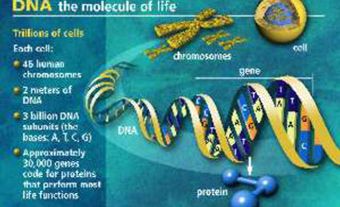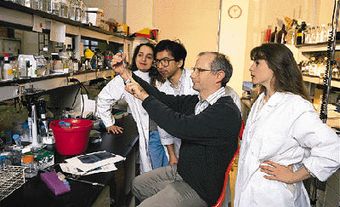Population genetics is the area of genetics that studies the distribution of genes (the units of genetic inheritance) and genotypes (the genetic complement at one or more loci), and the mechanisms determining genetic variability within a population. A population is a group of individuals among whom marriages potentially can occur; thus, French Canadians, Japanese Canadians and American Indian tribes constitute populations. Large populations are usually subdivided into smaller groups constituting geographic, religious or ethnic units. In addition to contributing to our understanding of evolution, population genetics theory can be applied to evaluating the long-term consequences of genetic screening programs and genetic counselling. Genetic variability is determined by the forces of evolution: mutation, natural selection, random genetic drift and migration.
Mutation
Mutation is a spontaneous or induced alteration in the information encoded in a cell's genetic material. When a chromosome replicates itself many kinds of errors can occur: substitution, addition, deletion or transposition of DNA nucleotides. Mutation is the ultimate source of genetic variation, although most newly arising mutations when made homozygous (the situation arising when each parent provides identical alleles, ie, alternate forms of a gene at a locus on a particular chromosome) are harmful in normal environments. The harmful allele is kept at a very low frequency by a balance between recurrent mutation and loss by selection. Increased mutation rates, caused by radiation or chemical mutagens, may have serious long-term consequences for a population.
Natural Selection
An individual's "fitness" is his or her ability to survive to maturity and to reproduce. Should an environmental change favour the survival and reproduction of an individual carrying a rare allele (perhaps a new mutation), then that individual will contribute more offspring to the next generation. Over time, the frequency of that particular allele will increase in the population. This process is the principle of natural selection. One way that alleles can be maintained in a population at intermediate frequencies - a polymorphism - is by selection for heterozygotes (individuals carrying 2 different alleles at the same locus on the chromosome pair).
The structure of a population interacts with the forces of evolution to determine the distribution of genotypes within it. Included in the effects of population structure are deviations from random mating resulting from, for example, marriages among relatives or subdivision of the population into smaller groups. The effect of inbreeding is to increase the chance that the offspring inherit 2 identical copies of a particular gene that was present in a common ancestor. Thus, inbreeding increases the chance of appearance of a rare recessive trait if it is present in the population.
Random Genetic Drift and Migration
Chance genetic fluctuations, called random genetic drift, result in dispersion of gene frequencies of small, genetic isolates as time goes on. The effect is greater the smaller the population size. Migration among subpopulations counteracts the genetic differentiation caused by genetic drift. Genetic isolates are usually founded by a small number of ancestors and thus some alleles will be lost by chance while others are retained. If a founder happens to be a carrier of an otherwise rare allele and has many descendants, the allele - be it harmful or not - may reach an appreciable frequency as a result of genetic drift. Endogamous populations that have apparently elevated frequencies of one or more recessive genetic diseases have been studied in various regions of the world. For example, hereditary tyrosinemia, an inborn error of metabolism, has been studied in French Canadians in Québec. It is important to recognize that, while a particular inherited disorder may be elevated in frequency, other inherited disorders may be relatively less common and many will be absent.
One component of human genetic variation is expressed as a hereditary disorder of genetic susceptibility to a disease induced by environmental agents. In BC it has been estimated that approximately 6% of individuals will suffer during their lifetime from a disability or handicap caused by a single gene disorder, chromosomal aberration, other congenital malformation or multifactorial disorder.
Ethnic variability in genetic disease has been documented. Thalassemia (often fatal anemia associated with enlargement of the liver and alteration in bones and skin) is relatively more frequent, and cystic fibrosis is relatively less frequent in Mediterranean peoples compared to other Caucasian populations. Tay-Sachs disease, phenylketonuria and albinism are inborn errors of metabolism that are infrequently encountered. Tay-Sachs disease is relatively more common and phenylketonuria less common in the Ashkenazi Jewish population. Albinism is relatively more frequent in some American Indian groups.
The total amount of genetic variation in humans is not known exactly but it must be large. Surveys of genetic variation of DNA, enzymes and blood-group markers suggest that all human beings - with the exception of identical siblings - are genetically unique. Furthermore, most human genetic diversity occurs among individuals comprising a "racial" group (the visible variations that have typically been used to define "race" make up a rather small proportion).
Anthropologists have attempted to establish the affinities between populations by analysing differences in gene frequencies. North American Native groups can be clustered on the basis of genetic distances. The patterns of genetic similarity correlate to varying degrees with linguistic and cultural relationships. However, there is still controversy over the evolutionary interpretation of genetic similarities and differences among groups of descendants of the aboriginal populations.

 Share on Facebook
Share on Facebook Share on X
Share on X Share by Email
Share by Email Share on Google Classroom
Share on Google Classroom


